|
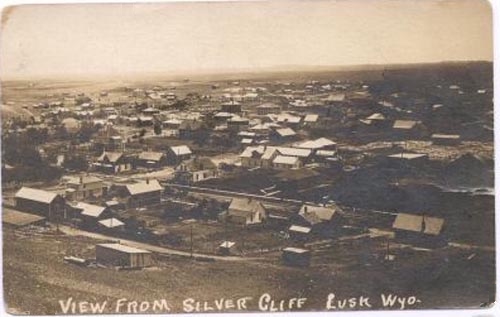
Lusk, 1919.
With the oil boom discussed on the preceding page, a construction boom overtook Lusk in 1919. Among the buildings started that year were
the Ranger Hotel and the Silver Cliff Hotel. Completion of the Ranger was, however, delayed. By 1935, only 40 rooms
had been completed. In that year, Roy Chamberlain purchased the hotel and completed construction.
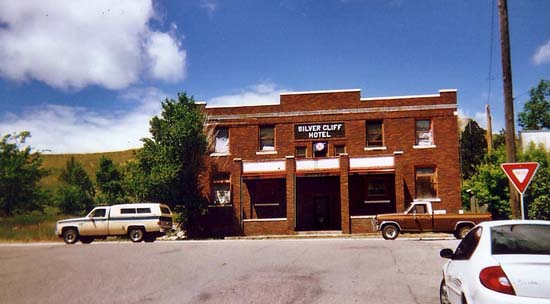
Silver Cliff Hotel, 2005. Photo by Geoff Dobson.
The Silver Cliff had 56 rooms. In back was a small garden with a pavillion. In the second floor
foyer were two paintings by Godfrey Broken Rope, an Indian artist. The hotel featured "radium" baths. In the 1920's, radium baths and use of
radium treated water was regarded as popular cure for all types of ailments including gout, arteriosclerosis, muscular
weakness, rheumatism, and thyroid propblems. The use of radium lost its popularity upon the death
of golfer Eben Byers, apparently from the effects of its overuse.
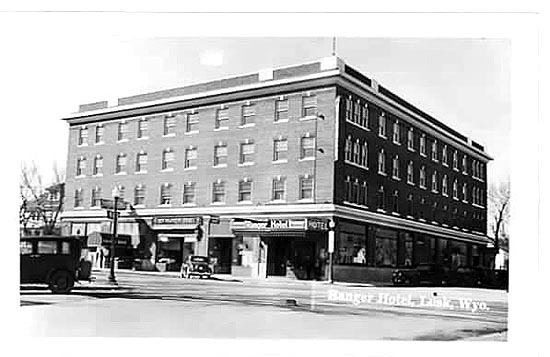
Ranger Hotel, approx. 1940.
A third hotel traces its beginnings to the Oil Boom of 1919, Dell Burke's Yellow Hotel across from the railroad depot.
As indicated by the next photo, Today, July 2005, the yellow stucco hotel
sits lonely and deserted, its windows broken out and its front porch in a state of collapse.
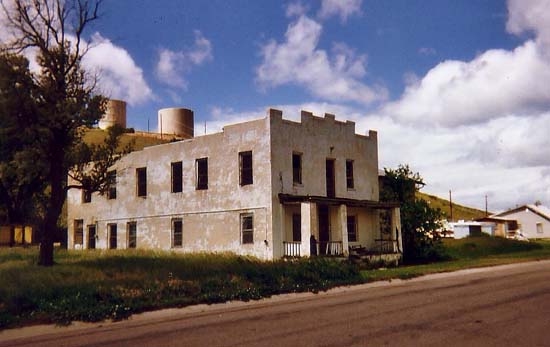
Remains of Dell Burke's Yellow Hotel, 2005. Photo by Geoff Dobson
Miss Dell, a petite redhead,
born Mary Ada Fisher, arrived in Lusk from Casper in 1919, setting up in
a tent. In Casper, the City Fathers were going through a crackdown on the Casper's
famous "Sandbar District." The Sandbar District, an area created when the
Platte River changed course because of the construction of a dam upstream, became the location
for many of the City's "cribs." Now, Casper takes a certain amount of perverse pride in its somewhat disrespectable past, with the
Sandbar lending its name to an urban renewal district and to a lounge.
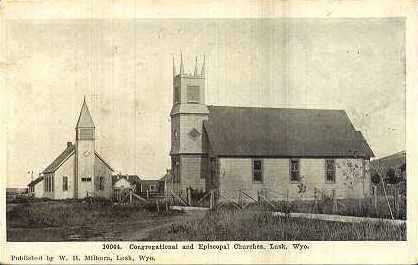 Congregational Church and St. George's Episcopal Church, Lusk, undated.
Congregational Church and St. George's Episcopal Church, Lusk, undated.
The Yellow Hotel continued in business until 1978. Over the years Miss
Dell contributed anonymously to the needy, bailed out the
power company during the depression, and never operated on Sunday, not wishing
the "boys to come here instead of going to church." At age 91 Miss Dell slipped and fell
on the sidewalk outside her hotel and spent the last several years of
her life in a care center. On her death in 1980 her estate was valued in
excess of $1,000,000. A country song, Dell was a lady was written in her
memory.
Although as indicated on the previous page, Lusk after the arrival of the railroad was a
"miniature Hell on Wheels," with dance halls, saloons, and establishments where ladies of the
evening plied their trade, churches arrived almost immediately. Among the oldest are
the Congregational Church, now located at 120 E. 5th St., and the Episcopal Church located at 120 W. 5th
Street. Both date back to a least the 1890's. The Congregational Church building as depicted in the
above photo is now a Baptish Church. The Congregational Church has a grand piano which was
donated in 1931 by Harmon and Opal Templeton. Templeton owned the Lusk Table Supply Store which
was the first "self-serve" grocery store in the area.
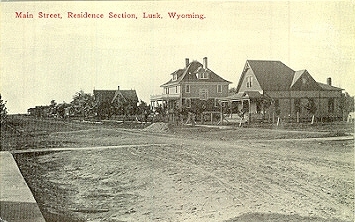 Main Street, residential section, Lusk, 1910
Main Street, residential section, Lusk, 1910
Present day Niobrara County in the late 1870's became a center of the cattle industry. Large
ranches operating in the area included the Swan Land and Cattle Company (the "Two Bar"), discussed with regard to
Chugwater, the Converse Cattle Company (the "O W") originally headquartered
on Old Woman Creek before it moved to Sheridan, the Node Ranch, the Pratt & Ferris Cattle Company (the "P F"),
and Hans Hanson's 77. Pratt & Ferris was originally started by Col. James Harvey Pratt and
Cornelius Ferris as a freighting outfit, carrying supplies to Pine Ridge and the
Black Hills. With funding from Marshal Field, an in-law of Pratt, and Levi Leiter, Field's partner, the
company expanding into cattle. Pratt eventually owned ranches along Clear Creek in Sheridan
County (the "Big Red"), Texas, Nebraska, as well as present day Goshen County (sometimes referred to as the "Rawhide," but not to be
confussed with the Rawhide Ranch owned by Russell Thorp, and the "P F"). For more on the
Thorp's Rawhide, see Deadwood Stage. Upon Leiter's death, the
ranches were split up, with R. S. Van Tassell (see next page), Oliver Henry
Wallopp, and E. W. Whitcomb acting as commissioners for purposes of the division.
Lusk continued on next page.
|